Into the Groove: When Curators, Artists, and Critics Dance
Christina Schmid on the "dancing together naked in public" that artists and critics do, as seen through the lens of an exhibition of work curated by Public Functionary's Tricia Heuring and a recent review of the show by Star Tribune art critic Gregory Scott.
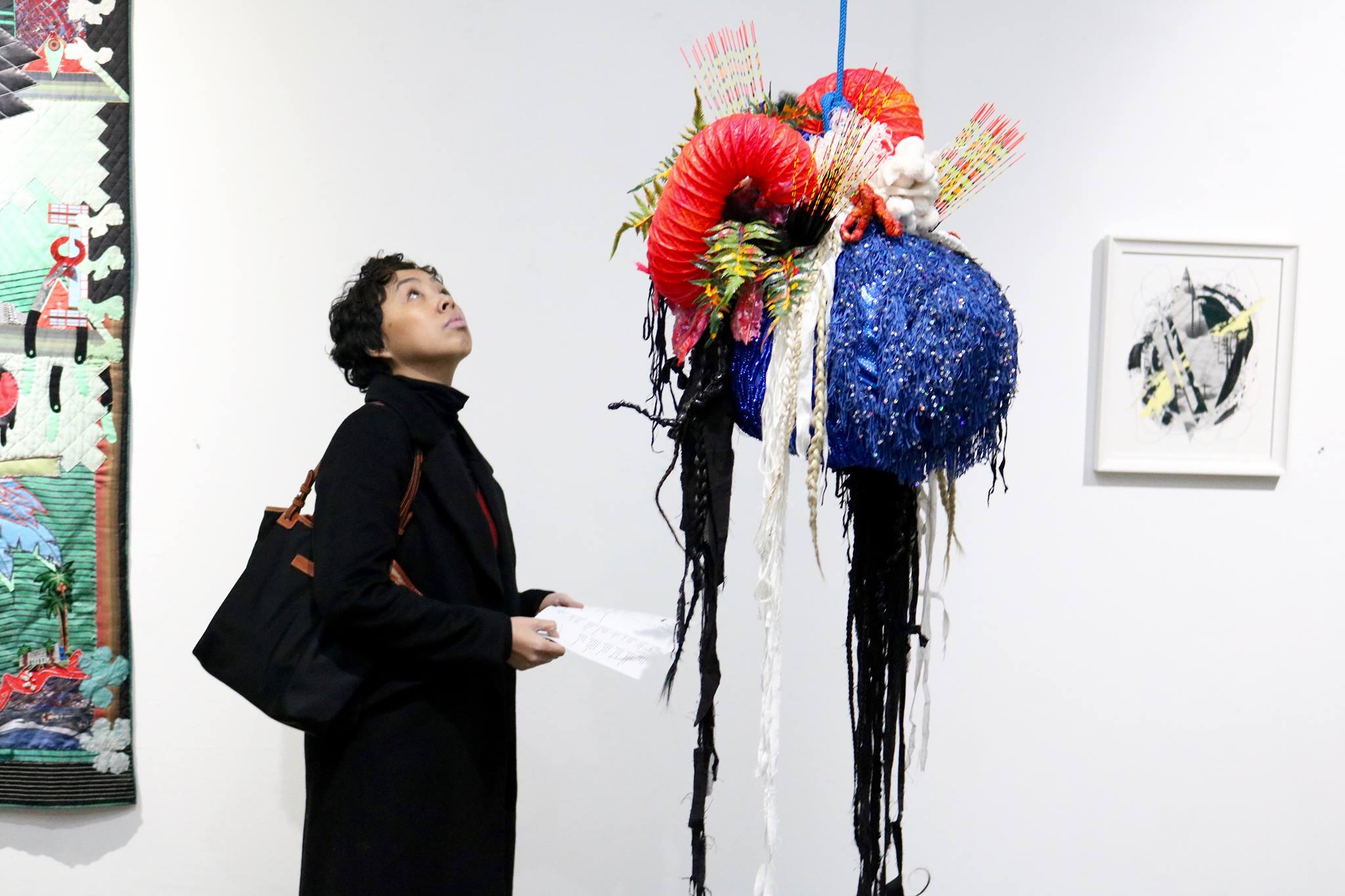
Dancing together naked in public — that’s what artists and critics do, according to Jerry Saltz. As soon as art enters into conversation with an audience, something is revealed about the work, its maker, and, of course, the people willing to respond. But while art audiences may choose to keep quiet, critics respond in public, for all to see. With each word and gesture, they reveal what they value: materiality, ideas, an abstract standard of excellence the work has to live up to, or context and community. (And the list could go on, of course). Once we choose to join the conversation that is art — as emancipated spectators, storytellers whose tales unfold through objects, self-appointed evaluators, thinkers, makers, rabble-rousers, and dreamers — two things happen: we claim our voice, which may feel empowering, and we make ourselves vulnerable for owning up to what we care about. Such vulnerability should not be shunned: it takes courage and, at its heart, is the basis for any authentic dialogue and thoughtful disagreement.
How we respond to each other’s vulnerability, our nakedness, speaks volumes, too. Do we applaud the courage it takes to shed your clothes in public and dance? Or do we jump at the chance to ridicule, belittle, and demean, as if we were, in so doing, somehow inviolable and fully dressed? Such choices, and all the shades in between, are revealing as well — and they are what I find myself wondering about after seeing Tricia Heuring’s latest curatorial adventure, Selected Works, at Public Functionary and reading Gregory Scott’s review of said show.
Scott writes as a journalist. A journalist’s job, to quote the singularly unsentimental Christopher Knight, art critic for The Los Angeles Times, is “to sell papers.” Or attract clicks. A degree of sensationalism has become normalized in today’s media culture. (The verdict on whether that’s actually a good thing is in, courtesy of Breitbart: it’s not.) Keeping all that in mind, Scott’s review is a truly odd mixture: he recognizes the risks Heuring took in her curatorial experiment and attunes to the fascinating material dialogues the show opens up, before dragging the curator’s personal life into a review of 22 artists’ work. Wasn’t there enough, you know, art to write about? And does it matter that all participating artists and the curator are women, many of them women of color, while Scott is a white man? Do I wonder whether exposing someone’s possibly painful personal life as an excuse for critical engagement and dismissing a complex show as “group therapy” would have happened under differently gendered circumstances? Yes, I do. This dance deserves some scrutiny.
Let’s start with some context: Heuring, who started curating in 2009 with the Iraqi and American Reconciliation Project, has run Public Functionary for the past three years. Initially funded through a successful Kickstarter campaign, the gallery has made its name for lavish solo shows, featuring artists of local, national, and international renown. Other than more established nonprofit spaces with their devoted audiences, Public Functionary, under Heuring’s leadership, has been reaching out to different communities: DJ’s and producers from the local music scene, fashion designers, the Northeast Minneapolis Arts Association, contemporary dance makers. Audiences keep morphing, and with each show (I have not seen all of them) the space is utterly transformed: from sparse and minimalist to lush and theatrical. Heuring has demonstrated a curatorial sensibility and approach unique in the Twin Cities. Then, she decided to shake things up. A curatorial residency in Colorado last summer provided the opportunity to reflect on her process, to ask questions both intimate and political. Some of them are included on the gallery booklet for Selected Works: “What is trust? Do you trust me?” “What is power. powerful?” “Do you care? Do we need to care?” These are not inconsequential questions.
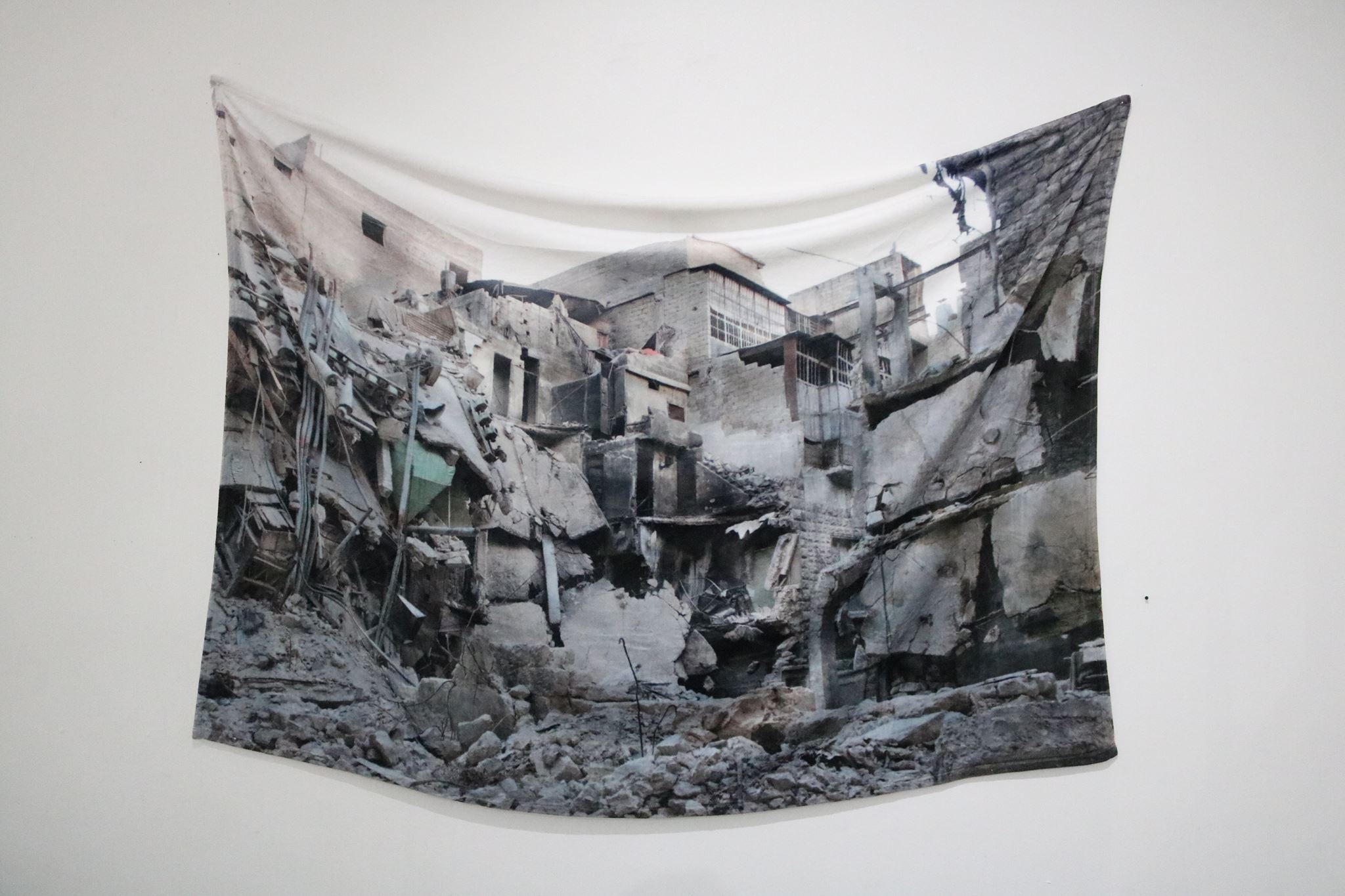
Selected Works is the first group show Heuring has curated for Public Functionary. At times, her political commitments still shine through, most notably in Essma Imady’s Receiving Blanket (2016), where a photograph of bombed out buildings printed on a blanket collides with the promise of cuddly comfort. But Heuring no longer sets out to make a clearly delineated argument, as she did in 2012 with Not About Bombs at Intermedia Arts. For Selected Works, she embraced an altogether different modus operandi: intuition.
Trusting intuition is complicated business and, in light of recent events, has only gotten more so. Claiming knowledge without verifiable facts? Check. Calling on gut instincts as a convenient excuse for lack of research and rigor? Check. And yet, the fact that invoking intuition is open to all sorts of abuses does not negate altogether that odd feeling of certainty, when we trust something without good cause. Art can be an arena to experiment with intuition: the stakes are markedly different than, say, in governance and policy. Artists have long sought out ways and means to circumvent the constraints of rationality and invite forms of non-volitional agency, ceding mastery over outcomes, and setting the stage for letting something else emerge. Whether we understand intuition as the result of rapid subliminal processing or “the quality of the not-yet that lurks at the edges of experience,” it offers rich ground for art. Erin Manning writes, “This, I want to propose, is art: the intuitive potential to activate the future in the specious present, to make the middling of experience felt where futurity and presentness coincide, to invoke the memory not of what was, but of what will be. Art, the memory of the future.”1
Heady, poetic words. They touch on the risks that working intuitively harbors: a deliberate indeterminacy often misunderstood as “unrigorous, flimsy, its lack of solidity mistaken for lack of consistency”2 and a vulnerability that arises from not yet having the words to name what is emerging. Manning compares intuition to a soccer player’s keen intelligence: rather than stand, reflect, and analyze, an effective player moves without thinking, responds to complex situations intuitively without weighing countless variables. This kind of choreographic thinking works best “when not curtailed by the imposition of narratives of volition and intentionality.”3 But not everyone who stops thinking in the middle of the soccer field will make an excellent player. It takes an interplay of timing, instinct, stamina, and who knows what else to let such virtuosity shine. Thus, Heuring’s experience and skill as a curator are far from irrelevant for her work on Selected Works.
The collection of objects here is not a mere illustration of curatorial process but an opportunity to attend to the strange, quivering agency of objects as it unfolds in exhibition. It’s an invitation to spend time in a space before meaning congeals, in those precious moments before a pundit tells you what to think.
To work intuitively, Heuring upped the pressure: in seven days, she scheduled conversations and studio visits with 22 artists. Each conversation lasted between an hour-and-a-half to almost twice as long. Granted, the artists were no strangers to her. In some cases, she had been following their work and practice for years. Her selections happened without a lot of time to reflect, conceptualize, and contemplate. Like the soccer player in mid-game, she wanted to respond without thinking. The exhibition brings together glimpses of these ongoing conversations. Though Heuring is the only constant, rich material dialogues crisscross the gallery space. Each time you shift your point of view, a different set of interactions arises: it’s impossible to map them all.
Selected Works mixes material experimentation, playful excess, and formal restraint. Most of the artwork on view is very recent, in line with Heuring’s ambition to present “a pulse, a moment.” Dyani White Hawk’s painting Day and Night, completed in 2011, is the oldest piece among selections that mostly date to 2016. Like several other artists in the show, White Hawk draws on and transforms cultural tradition: beads morph into brushstrokes and become abstract painting. Koua Mai Yang’s Back piece #7, Dab Tshos #7 (2016) references Hmong beliefs: “The ancestors are always watching,” her drawing reads. Histories of immigration and displacement are similarly prominent in Selma Fernandez Richter’s Karen’s Altar, Saint Paul, MN (2012), from the series The Ache for Home, and in Pao Houa Her’s elegant black and white photograph, Untitled (My Mother’s Flowers) (2016), a silk bouquet of tropical fronds. But while such histories are ever-present and lend a political edge to the show, they do not foreclose other material and formal dialogues.
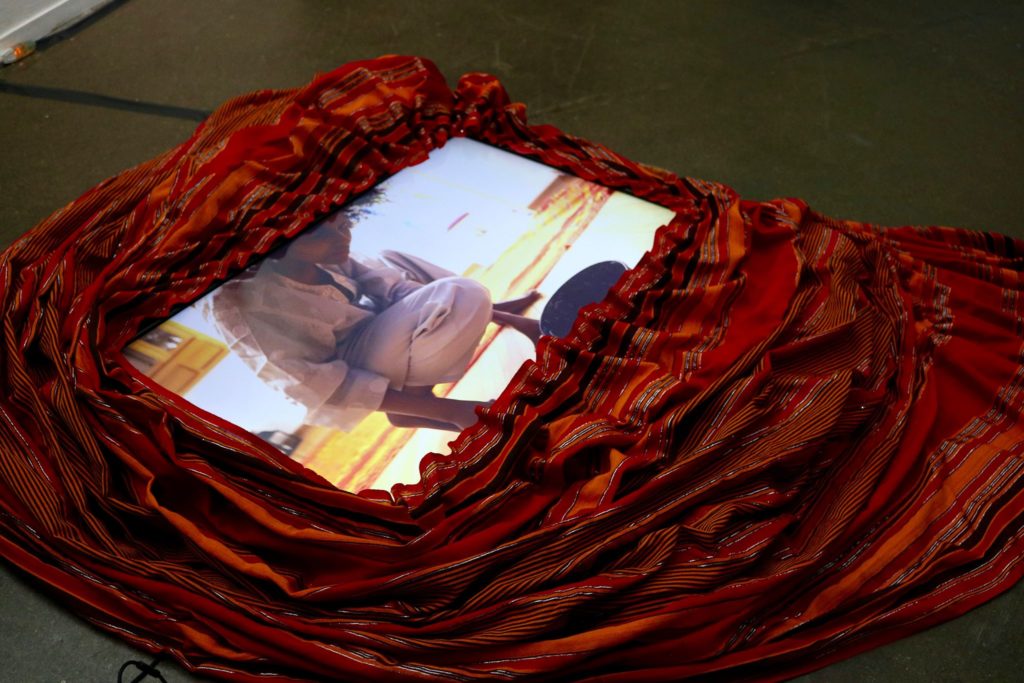
Her’s mother’s flowers, for instance, resonate with Mackenzie Owens’ acrylic painting, Black women breathe flowers too (2016), and the lush foliage in May Waver’s mobile phone footage, perennial 1 (2016). Small floral decals decorate some of Katayoun Amjadi’s porcelain casts of chicken carcasses in Nightingale and Rose (2016), an irreverent riff on a traditional romantic motif in Persian poetry. Be-flowered, gold-lustered or glazed in sickly red, the chickens are both funny and oddly disconcerting. Paint-splattered faux fern leaves jut from Kate Casanova’s mixed media sculpture that dangles from the ceiling in bulges of red paper lanterns, sequin-studded blue fabric, and braids of fake hair, right next to Lindsay Rhiner’s Tropical murder capital (2014), where bloody saw blades and blue palm trees sprout from fabric, plastic, and acrylic. Such material exuberance contrasts sharply with the subtlety of Tia-Simone Gardner’s haunting altered photograph, Kingston Harbour, 1948 (2016).
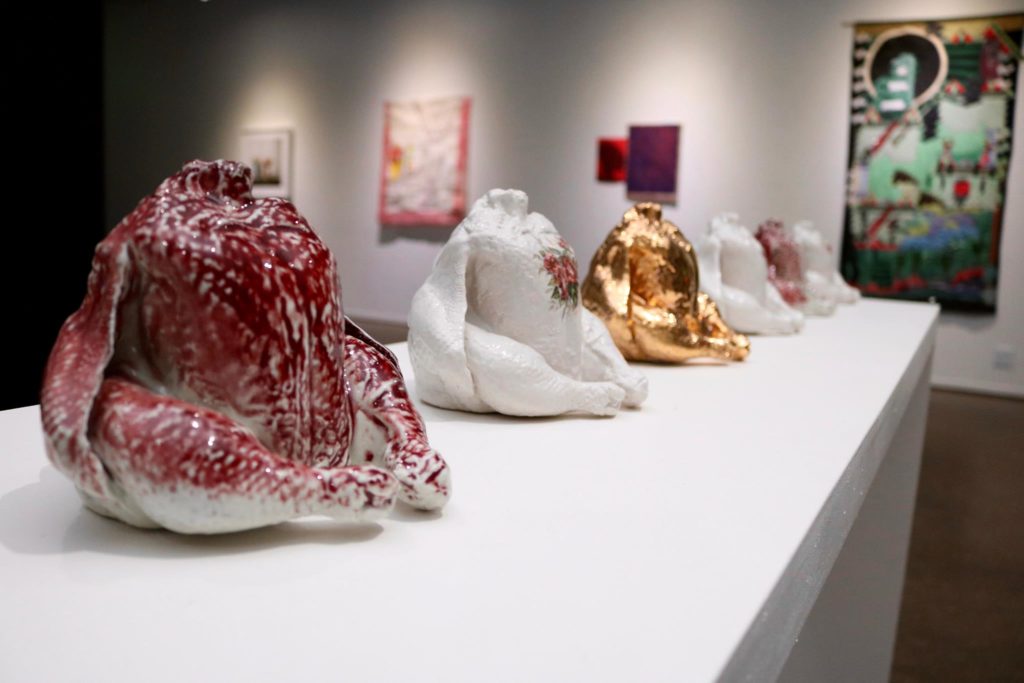
An uneasy assemblage, the exhibition is more than “a dedication to practice,” as Heuring puts it. Together, the works on view strike a minor chord whose harmonies are not resolved but resonate with an eerie sensibility: at turns elegiac — Mara Duvra’s You say this place feels posthumous (2016) is a case in point here — then humorous, as in Katelyn Rose White’s Baby, I’m Not Lying to You (2015), and at times demanding an intimacy that the work deliberately withholds. To hear the audio track to Ifrah Mansour’s video Can I touch it? (2016), you have to crouch on the floor next to a flatscreen wrapped in colorful cloth. Rather than resist such incompatibilities, Heuring, along with the artists, embraces this radical indeterminacy. After all, such “tentativeness in the act … jumps at the chance to discover what else an event can do.”4 This tentativeness does not register as insecurity, though, but conveys a speculative curiosity and a taste for experimentation (particularly palpable in Isa Gagarin’s, Lindsay Splichal’s, and Torey Erin’s work): there is no nostalgia for mastery here but an appetite for asking, what else? What if?
In The Minor Gesture, Erin Manning tries to put words to this fluid and always emergent sensibility. “Against the major tendency of seeking mastery,” she writes, “the minor gesture pulls the potential at the heart of a process into a mobile field.” This field makes “felt not only what the process can do but how the ecology of which it is part resonates through and across it.”5 The collection of objects, then, is not a mere illustration of curatorial process but an opportunity to attend to the strange, quivering agency of objects as it unfolds in Selected Works. It’s an invitation to spend time in a space before meaning congeals, in the strange anticipation of a dawning but still elusive insight, those precious moments before a pundit tells you what to think.
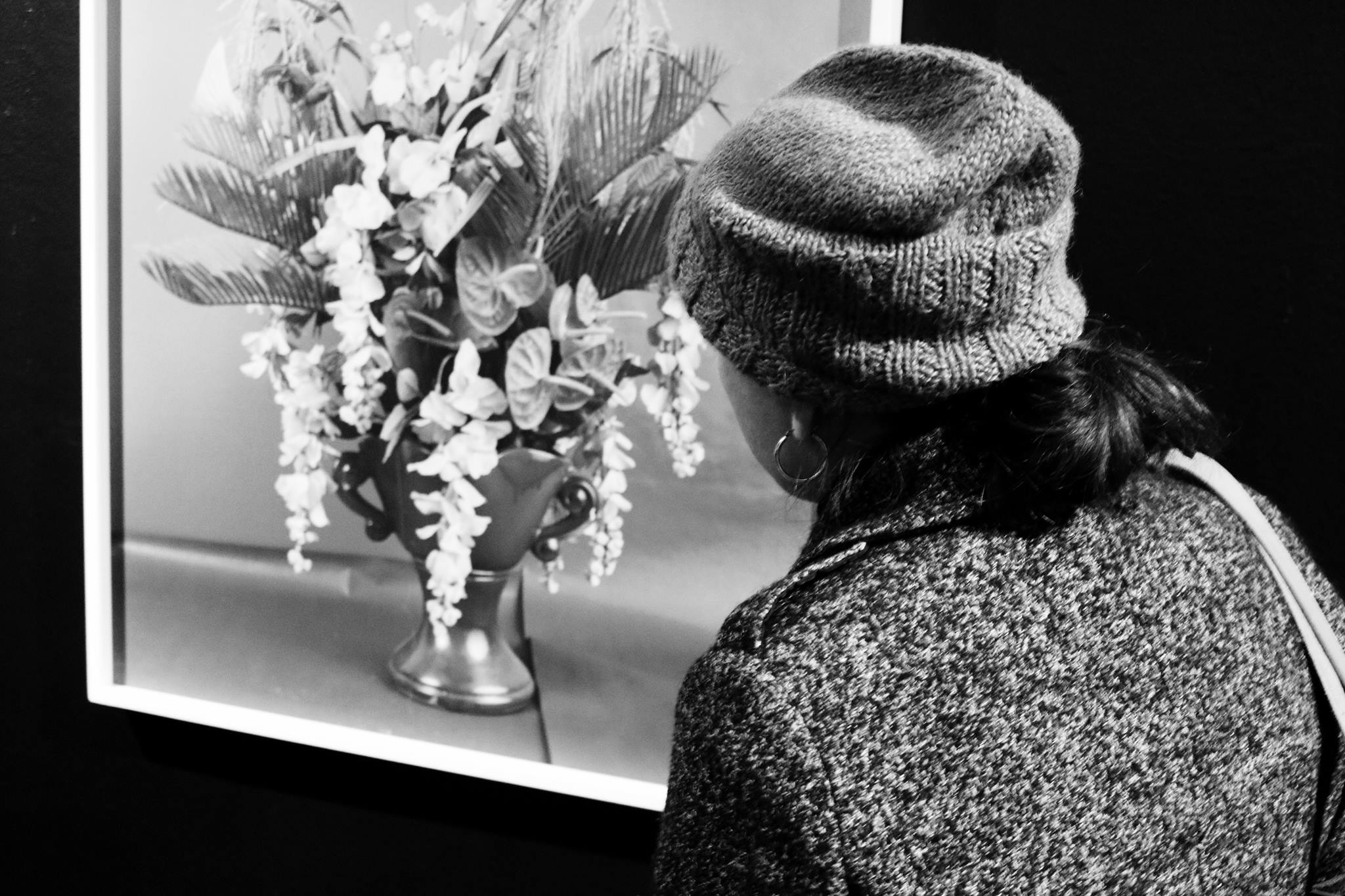
Telling you what to think is exactly what Scott does when he dismisses the show as group therapy. Let’s be clear: “the therapeutic value of making art is well known, and generally accepted.”6 What else is new? Let’s be equally clear that by suggesting that art only serves as therapy and has no further value actively diminishes its role as a vital part of cultural life, a means of making sense of a very confusing world. The latter qualities are what sets art apart, say, from the therapeutic value of yoga, the insights of psychoanalysis, or the balm mansplaining might offer to some fragile egos. Scott may have fallen prey to the illusion that he is dancing fully dressed, but no, the emperor’s new clothes conceal nothing at all.
The odd fact remains, though: Scott picked up on the tentative, tremulous quality of the show. “‘Selected’ is a wobbly show, but the shakiness is exciting. Ideas are being worked out before your eyes,” he writes, calling the show “vulnerable” and “a crucible of instinct and urgency.” Yet Scott seems ill at ease with such uncertainty. Rather than pursue his ideas about the show, he pompously diagnoses Heuring with an “art-centric flavor of Impostor Syndrome” and misreads the show as a symptom of the assumptions he makes about her private life. Of course, Heuring is not the first woman or curator to suffer such conjecture. What is surprising, though, and not in a good way, is that Scott and The Star Tribune seem to mistake such tabloid appetites for art criticism.
Noted exhibition details: Selected Works is on view at Public Functionary in Minneapolis through December 30, 2016.